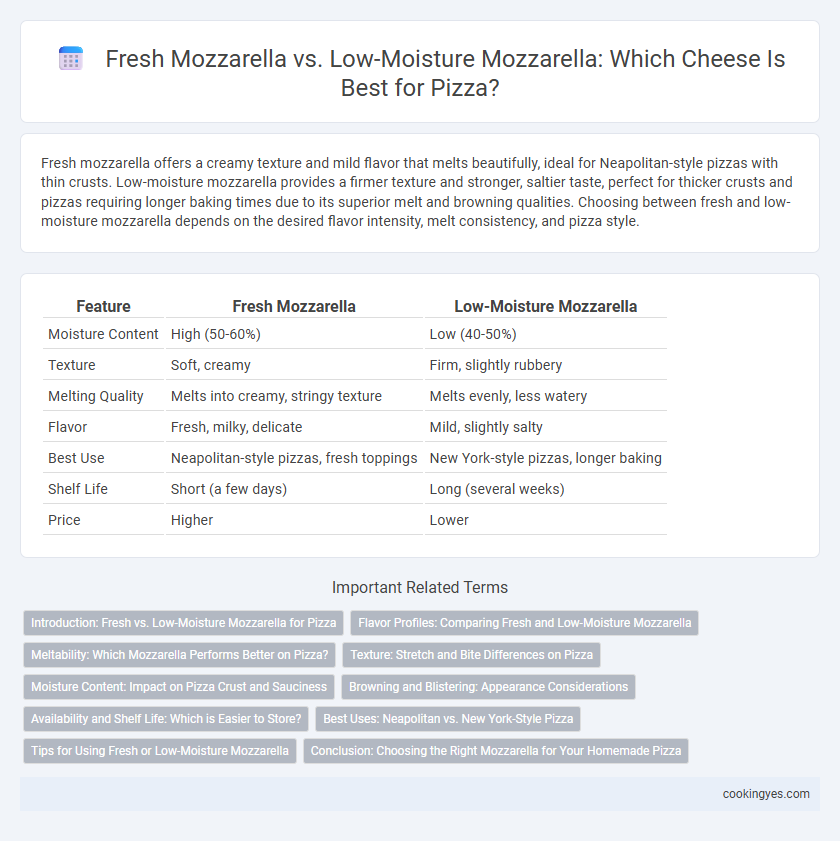Fresh mozzarella offers a creamy texture and mild flavor that melts beautifully, ideal for Neapolitan-style pizzas with thin crusts. Low-moisture mozzarella provides a firmer texture and stronger, saltier taste, perfect for thicker crusts and pizzas requiring longer baking times due to its superior melt and browning qualities. Choosing between fresh and low-moisture mozzarella depends on the desired flavor intensity, melt consistency, and pizza style.
Table of Comparison
| Feature | Fresh Mozzarella | Low-Moisture Mozzarella |
|---|---|---|
| Moisture Content | High (50-60%) | Low (40-50%) |
| Texture | Soft, creamy | Firm, slightly rubbery |
| Melting Quality | Melts into creamy, stringy texture | Melts evenly, less watery |
| Flavor | Fresh, milky, delicate | Mild, slightly salty |
| Best Use | Neapolitan-style pizzas, fresh toppings | New York-style pizzas, longer baking |
| Shelf Life | Short (a few days) | Long (several weeks) |
| Price | Higher | Lower |
Introduction: Fresh vs. Low-Moisture Mozzarella for Pizza
Fresh mozzarella offers a creamy texture and mild flavor that melts into a smooth, rich topping perfect for Neapolitan-style pizzas. Low-moisture mozzarella provides a firmer texture with less water content, resulting in a longer shelf life and a more pronounced stretch and browning that suits New York-style pies. Choosing between fresh and low-moisture mozzarella depends on desired melt quality, moisture levels, and pizza style preferences.
Flavor Profiles: Comparing Fresh and Low-Moisture Mozzarella
Fresh mozzarella offers a creamy, delicate flavor with a subtle sweetness that enhances the freshness of pizza toppings, while low-moisture mozzarella provides a richer, more concentrated taste with a slightly tangy note ideal for achieving a classic, golden-bubbly crust. The higher moisture content in fresh mozzarella results in a softer texture and a milky aroma, whereas low-moisture mozzarella's drier consistency contributes to better meltability and stretch, creating the traditional pizza cheese experience. Choosing between the two depends on whether a light, fresh flavor or a more robust, savory profile is desired for the pizza.
Meltability: Which Mozzarella Performs Better on Pizza?
Fresh mozzarella offers superior meltability with a creamy texture that creates smooth, stringy cheese pulls, ideal for traditional Neapolitan-style pizza. Low-moisture mozzarella melts more evenly and holds its shape better during baking, making it a favorite for New York-style pizzas where a consistent, slightly firmer melt is preferred. Choosing between the two depends on desired melt texture and pizza style, with fresh mozzarella excelling in creamy melt and low-moisture providing controlled stretch and browning.
Texture: Stretch and Bite Differences on Pizza
Fresh mozzarella offers a creamy, soft texture with a high moisture content that creates an elastic stretch and a tender bite on pizza. Low-moisture mozzarella has a denser, firmer texture that produces a more pronounced chew and a longer-lasting stretch. The choice between the two affects the overall mouthfeel, with fresh mozzarella giving a delicate, melt-in-your-mouth quality and low-moisture mozzarella delivering a robust, traditional pizza cheese experience.
Moisture Content: Impact on Pizza Crust and Sauciness
Fresh mozzarella has a high moisture content, typically around 50-60%, which melts into a creamy texture, resulting in a moist, tender pizza crust with a slightly watery sauce. Low-moisture mozzarella contains about 45% moisture or less, providing a denser, firmer melt that prevents excess liquid, helping to maintain a crispier crust and more concentrated sauce flavor. Choosing between fresh and low-moisture mozzarella significantly influences the pizza's texture, with fresh mozzarella enhancing sauciness and softness, while low-moisture mozzarella promotes a firmer, well-structured crust.
Browning and Blistering: Appearance Considerations
Fresh mozzarella offers a creamy texture with minimal browning and blistering, resulting in a soft, white appearance on pizza. Low-moisture mozzarella undergoes a drying process that promotes caramelization, producing a golden-brown crust with characteristic blistering and a more visually appealing, bubbly texture. Chefs often choose low-moisture mozzarella for its superior browning and blistering that enhance the pizza's overall presentation and flavor profile.
Availability and Shelf Life: Which is Easier to Store?
Fresh mozzarella offers a delicate, creamy texture but has a short shelf life of about one week when refrigerated, making it less convenient for long-term storage. Low-moisture mozzarella, widely available in grocery stores, boasts a longer shelf life of several weeks to months and is easier to store without rapid spoilage. For pizza enthusiasts prioritizing accessibility and extended storage, low-moisture mozzarella is the practical choice.
Best Uses: Neapolitan vs. New York-Style Pizza
Fresh mozzarella offers a creamy, delicate texture and high moisture, making it ideal for Neapolitan pizza where a soft, melty cheese with subtle sweetness complements the thin, airy crust. Low-moisture mozzarella has a firmer texture and lower water content, allowing it to brown evenly and provide a stretchy, gooey consistency perfect for New York-style pizza's thicker, chewier base. Choosing between the two cheeses depends on the desired pizza style, with fresh mozzarella enhancing traditional, artisan pies and low-moisture mozzarella suiting heartier, more robust slices.
Tips for Using Fresh or Low-Moisture Mozzarella
Fresh mozzarella offers a creamy texture and mild flavor ideal for Neapolitan-style pizzas, but it releases more moisture, so draining and patting it dry prevents soggy crusts. Low-moisture mozzarella melts evenly with a slightly firmer texture, making it perfect for thicker-crust or New York-style pizzas where stretchiness and browning are desired. For optimal results, slice fresh mozzarella thinly and use low-moisture in larger shreds or cubes to balance moisture and meltability on your pizza.
Conclusion: Choosing the Right Mozzarella for Your Homemade Pizza
Fresh mozzarella offers a creamy texture and mild flavor ideal for Neapolitan-style pizzas, while low-moisture mozzarella provides a firmer texture and superior meltability, perfect for New York-style or thick-crust pizzas. The choice depends on whether you prioritize moisture content and richness or stretch and browning. Selecting the right mozzarella enhances your homemade pizza's flavor profile and texture, ensuring a more authentic and satisfying result.
Fresh mozzarella vs Low-moisture mozzarella for pizza cheese Infographic

 cookingyes.com
cookingyes.com